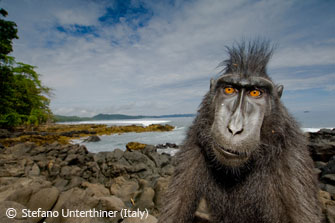 Feast your eyes on five of the winning photographs of the London Natural History Museum and BBC Magazine’s Wildlife Photographer of the Year 2008 Competition. Both professional and amateur, youth and adult photographers are invited to submit pictures in 17 categories. An exhibit of all the winning photos is on display at the Natural History Museum.
Feast your eyes on five of the winning photographs of the London Natural History Museum and BBC Magazine’s Wildlife Photographer of the Year 2008 Competition. Both professional and amateur, youth and adult photographers are invited to submit pictures in 17 categories. An exhibit of all the winning photos is on display at the Natural History Museum.
Right: Troublemaker by Stefano Unterthiner, Italy, Animal Portraits winner – Nikon D2X + Nikon 12-24mm lens; 1/250 sec at f10; ISO 125; graduated neutral-density filter; flash. — “I think Troublemaker’s expression captures the spirit of these wonderful monkeys,” Black-crested macaques.
American Steve Winter took home grand honors as Wildlife Photographer of the Year, among a record field of 32,351 entries from 82 countries. Winter spent ten months setting up 14 remote-controlled cameras, camping in freezing conditions in isolated areas of northern India and Pakistan, tracking the extremely rare snow leopard. Steve, from Hoboken in New Jersey, finally got the photo he envisioned, a snow leopard walking amidst falling snow, an endangered cat in an extreme environment.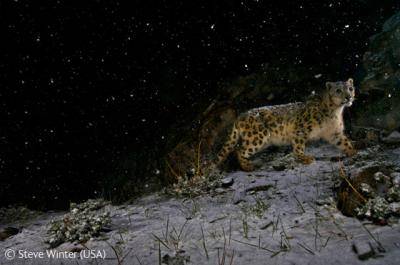
Competition judge Mark Carwardine said ‘Everything comes together in this striking picture – the drama of the snow, the mystery of the darkness, the posture of the rarely photographed snow leopard and the intriguing composition’.
Left: Snowstorm Leopard by Steve Winter, Wildlife Photographer of the Year (Canon EOS Rebel XT + 10-22mm lens at 16mm; 1/200 sec at f16; ISO 100; waterproof camera box + Plexiglass tubes for flashes; Trailmaster 1550-PS remote trigger) — ‘There are only a few thousand of these animals left in the wild. I was thrilled to have finally captured the shot I had dreamed of – a wild snow leopard in its true element,’ Steve said.
British teenager Catriona Parfitt, from Swanwick near Southampton, took the Young Wildlife Photographer of the Year title.
One of the Highly Commended winners in the adult category, Animals in their Environment, was this shot (below) called Whooper lift-off, by Ellen Anon, of the USA.
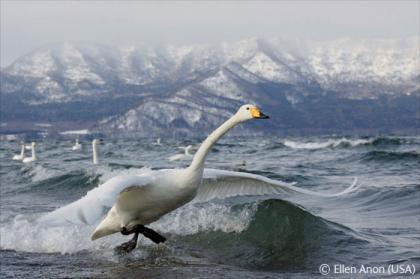 “My fingers, double-gloved, had gone numb. Waves on Japan’s Lake Kussharo, Hokkaido, were starting to freeze solid, and I was in awe that these gorgeous birds could face the water. By now, the wind had churned the lake up into white peaks that echoed the snowy mountains behind. When one swan began to taxi along the churning runway, I managed to make my frozen index finger release the shutter just before it took off.” Like its close North American relative the trumpeter swan, whooper swans are named after their distinctive loud call, heard from flocks on the water or in flight.” (Photo taken with: Canon EOS-1D Mark II + Canon 28-300mm f3.5-5.6 lens; 1/800 sec at f11; ISO 400)
“My fingers, double-gloved, had gone numb. Waves on Japan’s Lake Kussharo, Hokkaido, were starting to freeze solid, and I was in awe that these gorgeous birds could face the water. By now, the wind had churned the lake up into white peaks that echoed the snowy mountains behind. When one swan began to taxi along the churning runway, I managed to make my frozen index finger release the shutter just before it took off.” Like its close North American relative the trumpeter swan, whooper swans are named after their distinctive loud call, heard from flocks on the water or in flight.” (Photo taken with: Canon EOS-1D Mark II + Canon 28-300mm f3.5-5.6 lens; 1/800 sec at f11; ISO 400)
The next photo, Osprey snatch, by Paul Hobson from the UK, was especially commended in the adult category of Animal Behavior-Birds. Paul almost didn’t get this picture.
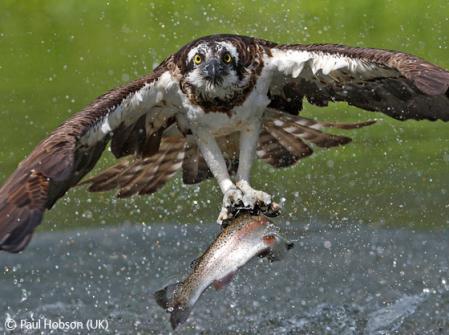
“I lived in a hide overlooking a lake in Pohtiolampi, Finland, for five days, waiting for ospreys to stop off to feed. For four days, the wind blew in the wrong direction, and the birds dived from behind the hide. Only on the last day did the wind change, allowing just this single shot of the osprey I had hoped for.”
Ospreys hover over water then dive, plunging into the shallows to grab prey. They have special feet to hold onto slippery fish scales: the soles are covered in spines and one talon can move so the bird can grip either side of the fish. Ospreys are found by rivers, lakes and lagoons all over the world. (Photo taken with: Canon EOS-1D Mark III + 300mm f2.8 lens; 1/3200 sec at f5 (-2/3 compensation); ISO 400)
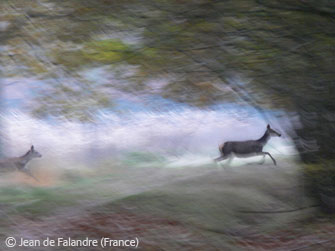
Jean de Falandre of France won the youth category, ages 11-14 with this photograph, Deer magic. (Shot with a Panasonic Lumix DMC-FZ30 + 71mm lens; 1/20 sec at f3.6; ISO 200)
View all the winning photos on the Natural History Museum website, here.




















Wonderful photos! Thank you!
Yes, I agree. I love animal stories and I love art stories…this is both in one! Its amazing what some of these photographers went through to get the perfect shot. That’s dedication!
I work in a natural history museum and this has inspired me, thanks!